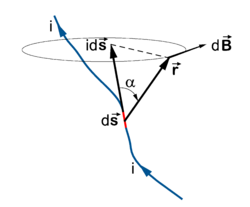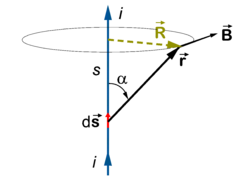Biot-Savart law
In physics, more particularly in electrodynamics, the law first formulated by Jean-Baptiste Biot and Félix Savart [1] describes the magnetic induction B (proportional to the magnetic field H) caused by a direct electric current in a wire. Biot and Savart interpreted their measurements by an integral relation. Laplace gave a differential form of their result, which now often is also referred to as the Biot-Savart law, or sometimes as the Biot-Savart-Laplace law. By integrating Laplace's equation over an infinitely long wire, the original integral form of Biot and Savart is obtained.
Laplace's formula
The infinitesimal magnetic induction at point is given by the following formula due to Laplace,
where the magnetic induction is given as a vector product, i.e., is perpendicular to the plane spanned by and . The constant k depends on the units chosen. In rationalized SI units k is the magnetic constant (vacuum permeability) divided by 4π. The magnetic constant μ0 = 4π ×10−7 N/A2 (newton divided by ampere squared). In Gaussian units k = 1 / c (one over the velocity of light). If we remember the fact that the vector r has dimension length, we see that this equation is an inverse distance squared law.
Formula of Biot and Savart
Take a straight infinitely long wire transporting the current i. Write, using R = rsinα (see the figure),
where is a unit vector perpendicular to the plane spanned by the wire and the vector perpendicular to the wire. Note that if moves along the wire all contributions from the segments to the magnetic induction are along this unit vector. Hence, if we integrate over the wire we add up all these contributions, so that
where, by the Pythagorean theorem,
Substition of y = s/R and y = cosφ/sinφ gives
where i is the current and R the distance of the point of observation of the magnetic induction to the wire. The constant k depends on the choice of electromagnetic units and is 10−7 henry/m [= Vs/A = N/A2] in rationalized SI units. This equation gives the original formulation of Biot and Savart.
References
- ↑ J.-B. Biot and F. Savart, Note sur le Magnétisme de la pile de Volta, Annales Chim. Phys. vol. 15, pp. 222-223 (1820)











